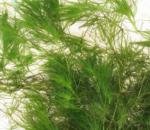Latin name
Caulinia graminea (Delile) Tzvel.
Family
Najadaceae
Common name(s)
Niad
Synonym(s)
Najas graminea Delile
Geographical distribution
Asia: Japan.
South and Southeast Asia: Bangladesh, India, Indonesia, Malaysia, Myanmar, Philippines, Thailand, and Vietnam.
Rest of the world: Australia, Egypt, Ethiopia, Kenya, Sudan, Uganda, and Zambia.
Morphology
A submerged, slender, and branched perennial aquatic herb.
Stem: round, very slender and long; has many branches and reaches a length of 20—60—cm.
Leaf: linear, opposite, 1—2—cm—long, finely toothed, inflated, and with toothed auricles at base.
Inflorescence: small, naked flowers, with male and female flowers on the same plant (monoecious).
Fruit: oblong-ellipsoid and achene about 2—mm—long.
Biology and ecology
Commonly found in shallow, stagnant fresh water, alkaline water, and brackish water of fishponds.
Propagated by seeds and stem fragments.
Agricultural importance
May impede water flow in irrigation canals and interfere with fisheries.
Management
Cultural control: hand weeding can be an effective control measure.
Chemical control: no record of chemical control.
Selected references
De Wilde WJJO. 1962. Najadaceae. Flora Malesiana Ser. 1 6: 157-171.Holm L, Plucknett DL, Pancho JV, Herberger JP. 1977. The world's worst weeds: distribution and biology. Honolulu, Hawaii (USA): University Press of Hawaii. 609 p.Merrill ED. 1976. A flora of Manila. Manila (Philippines): Department of the Interior, Bureau of Science. 491 p.Moody K. 1989. Weeds reported in rice in South and Southeast Asia. Manila (Philippines): International Rice Research Institute. 442 p.Noda K, Teerawatsakul M, Prakongvongs C, Chaiwiratnukul L. 1985. Major weeds in Thailand. Bangkok National Weed Science Research Institute Project. 142 p.Pancho JV, Soerjani M.1978. Aquatic weeds of Southeast Asia: a systematic account of common Southeast Asian aquatic weeds. Bogor (Indonesia): SEAMEO Regional Center for Tropical Biology (BIOTROP). 130 p.
Contributors
JLA Catindig, RT Lubigan, and DE Johnson
